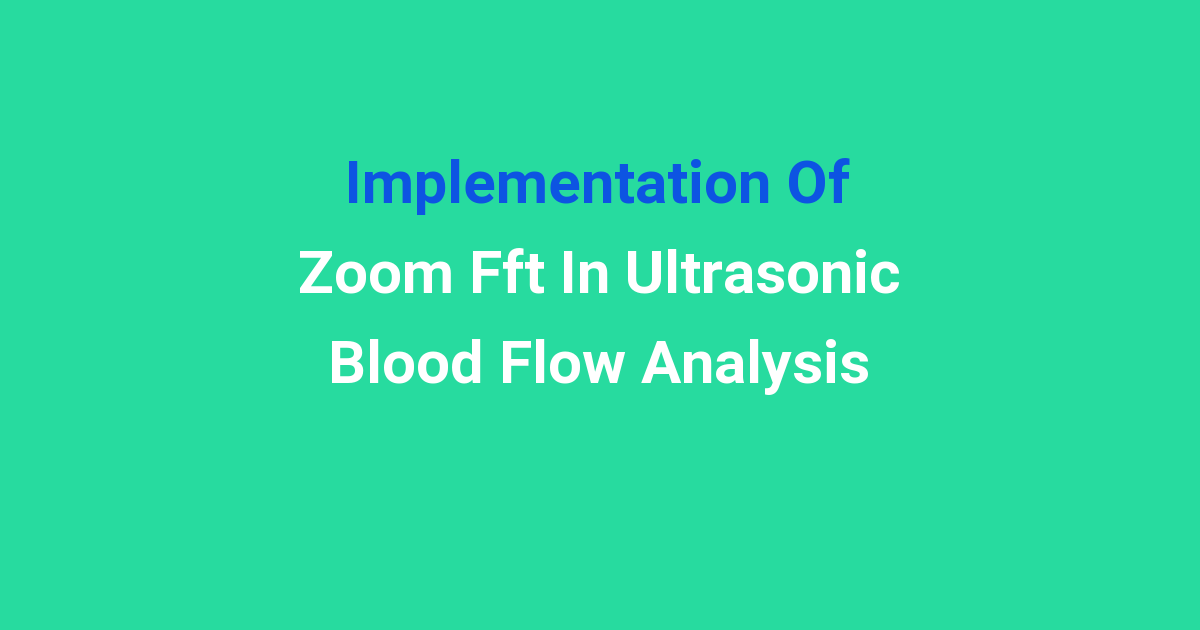The zoom FFT technique is used in the analysis of ultrasonic blood flow to enhance the resolution and accuracy of the analysis.
Implementation of Zoom FFT in Ultrasonic Blood Flow Analysis
Introduction
Ultrasonic blood flow analysis is a crucial component in medical diagnostics, allowing healthcare professionals to assess blood flow patterns and detect any abnormalities in circulation. One of the key techniques used in this analysis is the Fast Fourier Transform (FFT), which helps in transforming signals from the time domain to the frequency domain. However, traditional FFT methods have limitations in terms of frequency resolution and spectral leakage. In this project, we aim to implement the Zoom FFT algorithm in ultrasonic blood flow analysis to enhance the frequency resolution and reduce spectral leakage, leading to more accurate and precise results.
Problem Statement
The existing FFT methods used in ultrasonic blood flow analysis have limitations in capturing detailed frequency information due to their fixed resolution. This can lead to inaccuracies in detecting subtle changes in blood flow patterns, potentially affecting the diagnostic accuracy of the analysis. There is a need for a more advanced algorithm that can provide higher frequency resolution and reduce spectral leakage to improve the overall performance of ultrasonic blood flow analysis.
Existing System
The current system uses traditional FFT algorithms to analyze the blood flow patterns captured through ultrasound imaging. While FFT is effective in transforming signals to the frequency domain, it has limitations in terms of resolution and leakage. The fixed resolution of traditional FFT methods may not be sufficient to capture detailed frequency information, leading to inaccuracies in the analysis results. Moreover, spectral leakage, caused by side lobes in the frequency spectrum, can further distort the interpretation of blood flow patterns.
Disadvantages of Existing System
- Limited frequency resolution
- Spectral leakage leading to inaccuracies
- Difficulty in detecting subtle changes in blood flow patterns
- Potential impact on diagnostic accuracy
Proposed System
In our proposed system, we will implement the Zoom FFT algorithm in ultrasonic blood flow analysis to overcome the limitations of traditional FFT methods. The Zoom FFT algorithm allows for adjustable frequency resolution, enabling us to focus on specific frequency ranges of interest with higher precision. By reducing spectral leakage, the Zoom FFT algorithm will provide more accurate and detailed frequency information, enhancing the overall performance of blood flow analysis.
Advantages of Proposed System
- Higher frequency resolution
- Reduced spectral leakage
- Improved accuracy in detecting blood flow patterns
- Enhanced diagnostic capabilities
Features of Proposed System
- Adjustable frequency resolution
- Enhanced frequency range selection
- Improved signal-to-noise ratio
- Real-time analysis capabilities
Conclusion
In conclusion, the implementation of the Zoom FFT algorithm in ultrasonic blood flow analysis holds great potential for improving the accuracy and precision of diagnostic assessments. By addressing the limitations of traditional FFT methods, the proposed system will enable healthcare professionals to detect subtle changes in blood flow patterns with higher resolution and reduced spectral leakage. This innovative approach has the potential to advance the field of medical diagnostics and contribute to more effective patient care outcomes.

